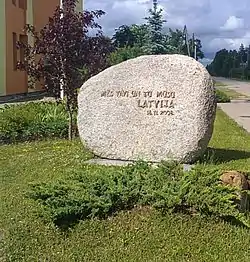Vaiņode
Vaiņode (formerly German: Wainoden; Lithuanian: Vainiauda) is a village in and centre of Vaiņode Municipality and Vaiņode Parish, Latvia. The village developed around a railway station after 1871 between Liepāja and Mažeikiai.
Vaiņode | |
|---|---|
Village | |
 | |
 Vaiņode Vaiņode's location in Latvia | |
| Coordinates: 56°24′55″N 21°51′04″E [1] | |
| Country | |
| Municipality | Vaiņode |
| Parish | Vaiņode |
| First mentioned | 1253 |
| Area | |
| • Total | 3.3 sq mi (8.5 km2) |
| Population (2015)[1] | |
| • Total | 1,759 |
History
The Vainode municipality (Bāta) was first mentioned in historical sources in 1253. The settlement was formed on the land of the Vaiņode Manor (German: Gut Wainoden) after construction of the Libau–Romny Railway in 1871. A summer cottage village Bāta was formed on the land of Lielbāta manor.
Starting in 1916 the Imperial German Navy built north of the village a military compound with an airship yard called Luftschiffhafen Wainoden with two large airship hangars which were later transferred and used as Riga Central Market. The base was used after World War I by the Latvian army, later in World War II again by the Germans. Afterwards it was a Red Army compound and the most important military airport in the Baltic region including ballistic missiles with a nuclear warheads.